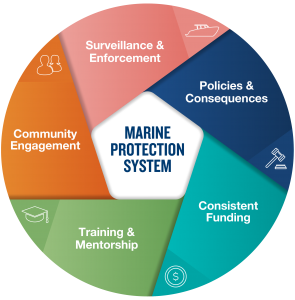By Natalie Lake, February 5, 2019
Effective marine protected areas (MPAs) and sustainable fisheries protect coral reefs, rejuvenate marine wildlife & habitats, provide jobs, and feed millions of people. In the past five years there has been a significant upsurge in their creation, but the reality is that nearly 60% of MPAs lack the necessary resources, training, and enforcement capacity to be successful.
For the last 20 years, WildAid’s marine program has built a comprehensive approach to marine protection. We’ve helped local government and non-profit partners succeed in building successful MPAs by collaborating closely with the right in-country partner organizations to design and implement comprehensive marine protection systems that incorporate both law enforcement and community partnership components. Our process looks at five key components of marine protection, which together comprise a comprehensive Marine Protection System: Surveillance & Enforcement, Community Engagement, Policies & Consequences, Training & Mentorship, and Consistent Funding.

As we continue to scale our marine program to reach new sites, WildAid needs a way to measure progress in establishing a Marine Protection System- one that is objective and consistent across sites. Thus, we developed a Marine Protection Index (MPI) to quantify our findings from the assessment process, establish a baseline measure for marine protection capacity, and better report our progress to our partners and the general public.
MARINE PROTECTION INDEX
We developed an initial version of the MPI in 2012, with 100 questions and various categories. In the first quarter of 2019, we streamlined and modified the pre-existing version to better adhere to our assessment process and the Marine Protection System model. The new version will begin trials this month.
The current MPI has two main sections: Process Indicators and Impact Indicators. The Process Indicators consist of 24 questions that are sub-divided into the five categories of the Marine Protection System. These questions include items such as:
- Is there a community outreach program?
- Are there sufficient staff to conduct enforcement operations?
- Are staff qualified to conduct their work?
Together, these 24 questions help to provide a score for how well the Marine Protection System has been implemented at that site.
The Impact Indicators consist of five questions to address main success factors, such as conservation outcomes (e.g. an increase in fish biomass or populations) and community benefits (e.g. increased community income due to the marine protected area). The higher the score, the better-protected the site.

Like the Project Feasibility Index (PFI), there are scoring guidelines for each question, and we use a five-point scale to grade each indicator. The MPI has been reviewed by the various enforcement experts in our team to ensure clarity, as well as a few in-country partners. This month, we have two assessment trips to Gabon and Tanzania scheduled, where our expert team of consultants will be using the MPI in the field for the first time. We will test for consistency across users, as well as ease of use, and determine scoring brackets for good, fair, and poor marine protection capacity.
The MPI can be a valuable tool in increasing the transparency of our approach, as well as providing our partners with measurable progress indicators as they implement their new enforcement plans.
Like the PFI, and Regional Leadership Hubs, the MPI allow us to better expand our program. We look forward to sharing additional lessons learned with you as we continue scaling WildAid’s marine program.